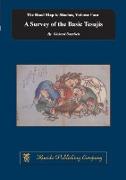- Start
- A Survey of the Basic Tesujis
A Survey of the Basic Tesujis
Angebote / Angebote:
In life-and-death situations and during the sharp skirmishes that arise in the middle game, brute-force analysis is usually required. However, intuition also plays a role in your ability to instantly find the key move that turns the position in your favor. Those key moves are called tesujis. There are about 45 different kinds of tesujis that a dan-ranked go player should be familiar with. If a player has solved many problems that involve a certain kind of tesuji, he or she will immediately recognize - almost unconsciously - positions in their games where that tesuji is applicable. This is called 'pattern recognition'. Of course, the player must confirm that it is indeed the required tesuji by the brute-force reading out of the continuation after the tesuji is played. This book presents more than 40 basic tesujis that arise in the game of go. Although there are only 38 sections, a number of different attachment tesuji are present in Section 4. After an example of a tesuji is presented and explained, three to 12 problems follow, showing the various ways that it can be applied. In all, there are 182 problems. Ifyouareahighkyu-levelplayer, yourgointuitionmaynotyetbewelldeveloped, so it will be hard to spot the correct tesuji, but you should not dwell too long on each problem. It is better to look at them as examples and make a best-guess move, then immediately look at the answer. In this way you can probably do 20 problems in an hour and get through the entire book in about a week. Your mind will no doubt be working full time, even while sleeping, to internalize the new knowledge that is being crammed into your brain. But the good news is that your intuition will be gradually developing. After finishing the entire book, go through it once more. Your mind will have already absorbed much of the new knowledge and you will recognize many patterns that keep recurring. After going through this book twice at high speed, you can then come back to it and look at the solutions in more detail and confirm the results. By developing your intuition in this way, you will be able to spot similar tesujis in your games. The aim of this book is to make the high kyu-level player aware of the various tesujis that can arise in their games. Once this awareness is achieved, the reader will want to test this newly acquired ability in a more practical setting. A good follow-up book is K54: 501 Tesuji Problems. The forty-five basic tesujis in this collection of problems are presented in random order multiple times, so it is similar to coming across them in games. Once the reader has mastered the problems in these two books, his or her ability at finding the winning tesujis in their games should be at the shodan level.
Folgt in ca. 10 Arbeitstagen
